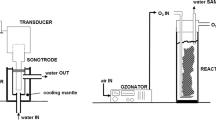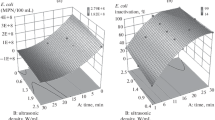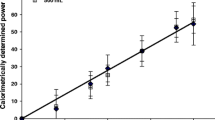Abstract
Biological wastewater treatment is mostly used in many industries to treat industrial influents. Treated water is consisting of an extremely high concentration of pathogenic microorganisms. Present work demonstrate the treatment of biologically treated sugar industry wastewater (BTSWW) using a low-frequency ultrasound (US). BTWSS consists of Enterobacter, Salmonella, and Escherichia Coli with a total coliform concentration of 2500 ± 300 CFU/mL. Experiments were performed using the individual effect of US, H2O2, and O3 and the combined effect of US with H2O2, O3, and H2O2 + O3. The complete removal of total coliform was obtained for the synergy effect of US with H2O2 and O3. The performance of the process was analyzed based on pseudo-first-order kinetic rate constant and synergy coefficient. The pseudo-first-order kinetic rate constant was 21.6 and 22.3 × 10–2 min−1 with a synergy coefficient of 2 and 1.9 for a combined effect of US with H2O2 and O3, respectively. Another advantage of the synergy of US and O3 was lower requirement of the initial dose of H2O2 (2.1 mM/L). The operational cost of the process was found to be $ 1.5 × 10–2 /MLD.
Graphical abstract

Highlights
• Complete microbial disinfection achieved in 20 min.
• The pseudo-first-order kinetic rate constant: 22.3 × 10–3 min−1 and synergy coefficient: 2 for US + O3.
• The operational cost of $ 1.5 × 10–2 /MLD for US + O3




Similar content being viewed by others
Data availability
Not Applicable
Code availability
Not Applicable
References
Haaken D, Dittmar T, Schmalz V, Worch E. Disinfection of biologically treated wastewater and prevention of biofouling by UV/electrolysis hybrid technology: Influence factors and limits for domestic wastewater reuse. Water Res. 2014;52:20–8.
de Oliveira Freitas B, de Souza Leite L, Daniel LA. Chlorine and peracetic acid in decentralized wastewater treatment: disinfection, oxidation and odor control. Process Saf Environ Prot. 2021;146:620–8.
Lovatel RH, Neves RM, Oliveira GR, Mauler RS, Crespo JS, Carli LN, et al. Disinfection of biologically treated industrial wastewater using montmorillonite/alginate/nanosilver hybrids. J Water Process Eng. 2015;7:273–9.
Uslu G, Demirci A, Regan JM. Disinfection of synthetic and real municipal wastewater effluent by flow-through pulsed UV-light treatment system. J Water Process Eng. 2016;10:89–97.
Yadav M, Sharma J, Yadav RK, Gole VL. Microbial disinfection of water using hydrodynamic cavitational reactors. J Water Process Eng. 2021;41: 102097.
Mohamad Mazuki NI, Teow YH, Ho KC, Mohammad AW. Techno-economic analysis of single disinfection units and integrated disinfection systems for sewage effluent reclamation. J Water Process Eng. 2020;36: 101398.
Gogate PR. Application of cavitational reactors for water disinfection: current status and path forward. J Environ Manage. 2007;85:801–15.
von Gunten U. Ozonation of drinking water: Part II. Disinfection and by-product formation in presence of bromide, iodide or chlorine. Water Res. 2003;37:1469–87.
Luo Y, Feng L, Liu Y, Zhang L. Disinfection by-products formation and acute toxicity variation of hospital wastewater under different disinfection processes. Sep Purif Technol. 2020;238: 116405.
Chopra AK, Sharma AK. Disinfection of biologically treated municipal wastewater using electrochemical process. Sep Sci Technol. 2014;49:2613–9.
Schmalz V, Dittmar T, Haaken D, Worch E. Electrochemical disinfection of biologically treated wastewater from small treatment systems by using boron-doped diamond (BDD) electrodes – Contribution for direct reuse of domestic wastewater. Water Res. 2009;43:5260–6.
Meghana M, Shastri Y. Sustainable valorization of sugar industry waste: status, opportunities, and challenges. Bioresour Technol. 2020;303: 122929.
Fito J, Tefera N, Kloos H, Van Hulle SWH. Physicochemical properties of the sugar industry and ethanol distillery wastewater and their impact on the environment. Sugar Tech Springer India. 2019;21:265–77.
Tiwari A, Sahu O. Treatment of food-agro (sugar) industry wastewater with copper metal and salt: Chemical oxidation and electro-oxidation combined study in batch mode. Water Resour Ind. 2017;17:19–25 (Elsevier B.V.).
Gupta VK, Jain CK, Ali I, Chandra S, Agarwal S. Removal of lindane and malathion from wastewater using bagasse fly ash - A sugar industry waste. Water Res. 2002;36:2483–90.
Sahu O, Mazumdar B, Chaudhari PK. Electrochemical treatment of sugar industry wastewater: process optimization by response surface methodology. Int J Environ Sci Technol. 2019;16:1527–40 (Springer Berlin Heidelberg).
Elayaraj B. Physico-chemical analysis of sugar factory effluent stress on seedling growth of black gram (Vigna mungo (L.) Hepper) varieties. Int Lett Nat Sci. 2014;17:85–93.
Sahu OP, Chaudhari PK. The Characteristics, Effects, and Treatment of Wastewater in Sugarcane Industry. Water Qual Expo Heal. 2015;7:435–44 (Springer Netherlands).
Ramjeawon T. Cleaner production in Mauritian cane-sugar factories. J Clean Prod. 2000;8:503–10.
Pandey PK, Kass PH, Soupir ML, Biswas S, Singh VP. Contamination of water resources by pathogenic bacteria. AMB Express. 2014;4:1–16.
WHO. Guidelines for drinking-water quality: fourth edition incorporating the first addendum. 2017.
Jyoti KK, Pandit AB. Effect of cavitation on chemical disinfection efficiency. Water Res. 2004;38:2249–58.
APHA. 4500-O OXYGEN ( DISSOLVED ) “Standard Methodes for the examination of water and wastewater” 2017.
APHA. 5220 Chemical Oxygen Demand (COD) “Standard Methods for the examination of water and wastewater.” Stand Methods Exam water wastewater. 2017.
Chand R, Bremner DH, Namkung KC, Collier PJ, Gogate PR. Water disinfection using the novel approach of ozone and a liquid whistle reactor. Biochem Eng J. 2007;35:357–64.
Rojas ER, Billings G, Odermatt PD, Auer GK, Zhu L, Miguel A, et al. The outer membrane is an essential load-bearing element in Gram-negative bacteria. Nature. 2018;559:617–21.
Hulsmans A, Joris K, Lambert N, Rediers H, Declerck P, Delaedt Y, et al. Evaluation of process parameters of ultrasonic treatment of bacterial suspensions in a pilot scale water disinfection system. Ultrason Sonochem. 2010;17:1004–9.
Vajnhandl S, Željko T, Majcen Le Marechal A, Valh JV. Feasibility study of ultrasound as water disinfection technology. Desalin Water Treat. 2014;55:1–7.
Gray NF. Ozone Disinfection. Microbiol Waterborne Dis. Elsevier; 2014. p. 599–615.
Rossi G, Mainardis M, Aneggi E, Weavers LK, Goi D. Combined ultrasound-ozone treatment for reutilization of primary effluent-a preliminary study. Environ Sci Pollut Res. 2021;28:700–10.
Laxma Reddy PV, Kavitha B, Kumar Reddy PA, Kim K-H. TiO2 -based photocatalytic disinfection of microbes in aqueous media: a review. Environ Res. 2017;154:296–303.
Hassen A, Mahrouk M, Ouzari H, Cherif M, Boudabous A, Damelincourt JJ. UV disinfection of treated wastewater in a large-scale pilot plant and inactivation of selected bacteria in a laboratory UV device. Bioresour Technol. 2000;74:141–50.
Rincón AG, Pulgarin C, Adler N, Peringer P. Interaction between E. coli inactivation and DBP-precursors - dihydroxybenzene isomers - in the photocatalytic process of drinking-water disinfection with TiO2. J Photochem Photobiol A Chem. 2001;139:233–41.
Al Bsoul A, Magnin J-P, Commenges-Bernole N, Gondrexon N, Willison J, Petrier C. Effectiveness of ultrasound for the destruction of Mycobacterium sp. strain (6PY1). Ultrason Sonochem. 2010;17:106–10.
Kobayashi Y, Hayashi M, Yoshino F, Tamura M, Yoshida A, Ibi H, Lee M-C-il, Ochiai K, Ogiso B. Bactericidal effect of hydroxyl radicals generated from a low concentration hydrogen peroxide with ultrasound in endodontic treatment. J Clin Biochem Nutr. 2014;54:161–5.
Rahdar S, Igwegbe CA, Ghasemi M, Ahmadi S. Degradation of aniline by the combined process of ultrasound and hydrogen peroxide (US/H2O2). MethodsX. 2019;6:492–9.
Egorova GV, Voblikova VA, Sabitova LV, Tkachenko IS, Tkachenko SN, Lunin VV. Ozone solubility in water. Moscow Univ Chem Bull. 2015;70:207–10.
Al-Hashimi AM, Mason TJ, Joyce EM. Combined effect of ultrasound and ozone on bacteria in water. Environ Sci Technol. 2015;49:11697–702.
Karel FB. Determining the effect of system parameters on ultrasonic water disinfection and enhancing its efficiency with a hybrid application. J Environ Biol. 2018;39:597–602.
Jyoti KK, Pandit AB. Hybrid cavitation methods for water disinfection: simultaneous use of chemicals with cavitation. Ultrason Sonochem. 2003;10:255–64.
Rekhate CV, Srivastava JK. Recent advances in ozone-based advanced oxidation processes for treatment of wastewater- A review. Chem Eng J Adv. 2020;3: 100031.
Acknowledgements
Mr. Maharshi Yadav would like to acknowledge the Technical Education Quality Improvement Program (TEQIP) of the Ministry of Human Resources and Development of the Government of India for providing a research assistant fellowship and contingency grant. Grant Number#MMMUT/AC/259/2018 dated July 18, 2018.
Author information
Authors and Affiliations
Corresponding author
Ethics declarations
All authors have agreed to submit the manuscript to Journal of Environmental Health Science and Engineering.
Ethics approval
Not Applicable
Consent to participate
All authors accept the policy of consent to participate.
Consent for publication
No human/animal study performed in present work. Hence it is not applicable.
Conflicts of interest
There is conflict interest among the authors to submit manuscript to Journal of Environmental Health Science and Engineering. Corresponding authors will make all communication with Journal.
Additional information
Publisher's note
Springer Nature remains neutral with regard to jurisdictional claims in published maps and institutional affiliations.
Rights and permissions
Springer Nature or its licensor holds exclusive rights to this article under a publishing agreement with the author(s) or other rightsholder(s); author self-archiving of the accepted manuscript version of this article is solely governed by the terms of such publishing agreement and applicable law.
About this article
Cite this article
Yadav, M., Gole, V.L., Sharma, J. et al. Biologically treated industrial wastewater disinfection using the synergy of low-frequency ultrasound and H2O2/O3. J Environ Health Sci Engineer 20, 889–898 (2022). https://doi.org/10.1007/s40201-022-00829-8
Received:
Accepted:
Published:
Issue Date:
DOI: https://doi.org/10.1007/s40201-022-00829-8




